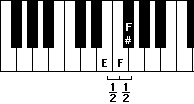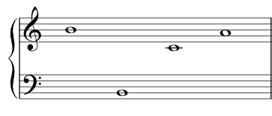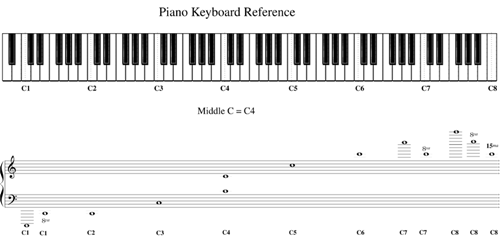Pitch refers to how high or low a note sounds.
Pitch ranges are often referred to in terms of the human singing voice.
For more detailed explanations of pitch and other properties of sound, see Unit 1 Sound Basics
Music is written on a music staff that consists of five lines and four spaces.
You can refer to the lines and spaces as follows.
The plural of staff is staves. Staves are often connected by a brace or bracket and bar lines.
Notes can be drawn on a line or a space. A note on a line is centered on the line. A note in a space is contained within the space between the lines.
In hand written music be careful to center notes on the line or draw them completely within the space. Otherwise, the note is ambiguous. Are the following two notes on lines or spaces?
Ledger lines are used to extend the range of the staff. Ledger lines can appear above or below the staff. They maintain the spacing of the staff lines and extend slightly beyond each note head. Ledger lines never extend further than necessary.
 |
The higher up the staff the note appears, the higher the pitch.
The musical alphabet consists of the letters A B C D E F G. Each letter corresponds to a specific line or space on the staff. As you move forward through the musical alphabet the pitch of each note gets higher. You could arbitrarily assign any staff line or space to represent the note A. The names of the other lines and spaces would follow from there.
A clef symbol is placed at the beginning of each staff to fix the location of a specific pitch on a specific staff line. Four clefs are in general use today: Treble, Bass, Alto, and Tenor.
When we put clefs into the example given earlier we get the musical alphabet from A to G in each of these four clefs.
Clefs are chosen to match the range of a voice or an instrument so that the majority of notes fall within the staff.
When these notes are notated in treble clef many ledger lines are necessary. However, they fit nicely in the bass clef.
Treble clef is part of a family of clefs known as G clefs. The curl in the treble clef symbol locates the note G on the staff.
![]()
The names of notes on the lines of the treble clef (EGBDF) can be remembered by the saying
Every Good Boy Does Fine or Elvis' Guitar Broke Down Friday.
The names of notes on the spaces of the treble clef (FACE) spell FACE.
When the line and space notes are combined, they form the musical alphabet.
Instruments that use the treble clef include the piano (right hand), violin, flute, trumpet, and guitar.
The two dots in the bass clef symbol locate the line that represents the pitch F. Because it defines the pitch F, the bass clef is referred to as a F clef.
![]()
The names of notes on the lines of the bass clef (GBDFA) can be remembered by the saying
Good Boys Do Fine Always
The names of notes on the spaces of the bass clef (ACEG) can be remembered by saying
All Cows Eat Grass or All Cars Eat Gas.
When the line and space notes are combined, they form the musical alphabet.
Instruments that use the bass clef include piano (left hand), cello, bassoon, and tuba.
The center point of the alto clef symbol locates the line that represents C. Because it fixes the pitch C, the alto clef is referred to as a C clef. The alto clef is used less often than the treble or bass clefs.
![]()
Perhaps you can make up sayings for these notes.
The primary instrument that uses the alto clef is the viola.
Tenor clef is also a C clef. The center point of the tenor clef symbol locates the line that represents C. The tenor clef is used less often than the treble or bass clefs.

Perhaps you can make up sayings for these notes.
Instruments that use the tenor clef include cello and trombone.
The piano keyboard consists of 88 keys arranged in repeating groups of white keys and black keys. Low notes are on the left side of the piano keyboard. High notes are on the right side of the piano keyboard. As you move from left to right on the piano, the pitch of each note gets higher.

The black keys of the piano are arranged in groups of twos and threes. Using these black key groups you can identify any note on the keyboard. For example, C is always the white key immediately to the left of a two black key group, and A is always between the second and third black key in a three black key group.

The white keys on the piano correspond to the musical alphabet A B C D E F G. You can always locate the note A on the piano by finding a group of three black keys and then playing the white key between between the second and third black key. Then names of the other white keys follow from there. The musical alphabet is repeated a little over seven times on the white keys of the piano keyboard.
Middle C is the C that is found in the middle of the piano keyboard.
In each clef there is an exact correlation between the letters of the musical alphabet, the notes on the staff, and the piano white keys. As the pitch of each note rises, you move forward through the musical alphabet, you move to the right on the piano, and you move up on the musical staff. Notice that each letter name has its own white key on the piano and its own corresponding place on the music staff.
![]()
![]()
The half step is the smallest unit of pitch used in Western music. Half steps occur naturally on the piano between any two adjacent piano keys, white to black, black to white, or white to white.
Two half steps occur naturally in the musical alphabet A B C D E F G, between B-C and E-F. They are referred to as Naturally Occurring Half Steps, NOHS. On the piano they are the white keys pairs that do not have a black key between them.
Two consecutive half steps make a whole step. Whole steps occur on the piano between the first and third key of any three adjacent piano keys, white to white, black to black, white to black, or black to white.
|
E - F# |
White - Black | |
| Bb - C | Black - White | |
| D - E | White - White | |
| Gb - Ab | Black - Black |
Listen to the sounds of half steps E-F, F-F# and the whole step E-F#.

|
E to F Half Step
|
F to F Sharp Half Step
|
E to F Sharp Whole Step
|
|
|
|
|
Whole steps occur naturally on the piano white keys, and in the musical alphabet A B C D E F G, between every letter pair except B-C and E-F. There are five pairs of naturally occurring whole steps: A-B, C-D, D-E, F-G, and G-A.
Notice that it's impossible to visually distinguish whole steps and half steps on a music staff without a clef.

You need to know the clef in order to know where B-C and E-F are.
An interval is the distance between two notes. The size of an interval is measured in half steps. The size of a half step is one half step. The size of a whole step is two half steps.
Another important interval is the octave. An octave is the interval between two notes that have the same name and are twelve half steps apart. If you start on any note of the piano and then play twelve successive half steps up or down you'll reach the note that has the same name as the one you started from. Those two notes are an octave apart. The root "oct" refers to the fact that an octave spans eight alphabet letters. An 88 key piano has a range of seven and a half octaves. We'll be studying more about intervals in Unit 11.

Accidentals are symbols that alter the pitch of a note. Five accidentals are used in music notation: the flat, sharp, double flat, double sharp, and natural.
| Name | Symbol | Effect |
| Flat | lowers pitch by half step | |
| Sharp | raises pitch by half step | |
| Double Sharp | raises pitch by whole step | |
| Double Flat | lowers pitch by whole step | |
| Natural | cancels previous accidental |
In music notation accidentals precede the note they affect. However, in speaking or text the accidental follows the note name. You say or write "G sharp" or "G#", not "sharp G."
 |
|
 |
|
 |
|
 |
|
Single accidentals raise or lower the pitch of a note by a half step. They are are the sharp, flat, and natural. Single accidentals are very common in music.
Double accidentals raise or lower the pitch of a note by two half steps or one whole step. They are are the double sharp and double flat. Double accidentals are much less common than single accidentals.
The natural is used to cancel a previously used sharp or flat. The following example illustrates an important musical rule.
Rule: Once an accidental is used within a measure it remains in effect until you reach the end of the measure or it is altered by another accidental.

Most, but not all, accidentals that appear in a piece of music are played on the black keys of the piano. The key immediately to the right (higher pitch) of any white key is called that key sharp. For example, the black key immediately to the right of D is called D#.
The key immediately to the left (lower pitch) of any white key is called that key flat. For example, the black key immediately to the left of E is called Eb.
Because there is only one black key between D and E, that black key has two different names. You cannot hear the difference between D# and Eb, but you can see the difference when they are written.

Black keys can be named with either sharps or flats. On the piano keyboard the black key between C and D can be thought of as a half step higher than C and called C# or as a half step below D and called Db. The names of the black keys using sharps would b: C# D# F# G# A#. The names of the same black keys using flats would be: Db Eb Gb Ab Bb.
Two notes that sound the same but have different names are called enharmonic notes. A# is the enharmonic equivalent of Bb.
The piano is an enharmonic keyboard because every key of the piano can represent three notes with the exception of G#-Ab.
B# and C are enharmonic notes. In this case B# is the same white key as C. Other enharmonic white key pairs are: E#-F, B-Cb, and E-Fb.
The chromatic scale is the scale of half steps. When you play every black and white key on the piano in sequence, you're playing the chromatic scale.
Here's the chromatic scale from A to A written first using sharps, then using flats. In the second example, note the use of the natural sign to cancel the flat on the previous note.
![]()
When writing an ascending chromatic scale, sharps are preferred. When writing a descending chromatic scale, flats are preferred. The preferred form keeps the number of accidentals to a minimum.
Half steps and whole steps can be further classified as diatonic or chromatic. The distinction lies in the alphabet letter name of the notes. If the two notes have different alphabet letter names they are diatonic. If they have the same alphabet letter name they are chromatic.

The grand staff consists of the treble clef and bass clef joined by a brace. All piano music is written using the grand staff, treble clef for the right hand and bass clef for the left hand.
In the early history of music notation, an ancestor of the grand staff was the eleven line staff. It's hard to read an eleven line staff quickly. Is the last note on the 7th, 8th, or 9th space?
If you split the eleven line staff in the middle and move five lines up and five lines down it's much easier to identify specific lines and spaces.
When you erase the middle line, add the treble and bass clefs, and join them with a brace you get the grand staff.
Here's the eleven line example in the Grand Staff.

Although Middle C is an invisible staff line shared between the treble and bass clefs, Middle C is never written in the middle of the grand staff. It is correctly written using ledger lines above or below the staff. Ledger lines are spaced the the same distance apart as the staff lines.
To uniquely name a pitch you have to identify three things, the alphabet name, the accidental (if used), and the octave designation. Several systems of pitch names have been used. We'll use a common one that defines middle C as C4. All other note names derive from that. The octave designation changes on every C.

If you look closely at the music example shown above, you'll see the symbol 8va placed either above a note or below a note. The 8va symbol is Italian for ottava, or octave. When it is placed above a note, the note is played one octave higher. When it is placed below a note, the note is played one octave lower. It is commonly used to reduce the number of ledger lines needed to write very high notes or very low notes.
Print this keyboard chart: KeyboardReference.pdf. Use it for reference when doing homework and bring it to every class.
Revised by John Ellinger, Spring 2012.